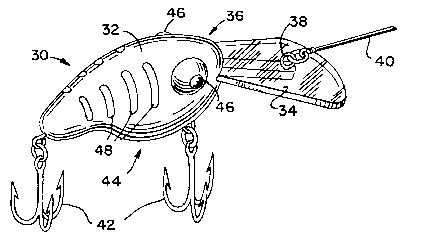Some of the information on this Web page has been provided by external sources. The Government of Canada is not responsible for the accuracy, reliability or currency of the information supplied by external sources. Users wishing to rely upon this information should consult directly with the source of the information. Content provided by external sources is not subject to official languages, privacy and accessibility requirements.
Any discrepancies in the text and image of the Claims and Abstract are due to differing posting times. Text of the Claims and Abstract are posted:
| (12) Patent: | (11) CA 2169429 |
|---|---|
| (54) English Title: | FISHING LURES HAVING LIGHT SENSITIVE COLOR CHANGE AND METHOD OF PRODUCING |
| (54) French Title: | APPATS PHOTOSENSIBLES ET METHODE DE PRODUCTION |
| Status: | Expired and beyond the Period of Reversal |
| (51) International Patent Classification (IPC): |
|
|---|---|
| (72) Inventors : |
|
| (73) Owners : |
|
| (71) Applicants : |
|
| (74) Agent: | RICHES, MCKENZIE & HERBERT LLP |
| (74) Associate agent: | |
| (45) Issued: | 2001-04-17 |
| (22) Filed Date: | 1996-02-13 |
| (41) Open to Public Inspection: | 1996-08-15 |
| Examination requested: | 1996-08-09 |
| Availability of licence: | N/A |
| Dedicated to the Public: | N/A |
| (25) Language of filing: | English |
| Patent Cooperation Treaty (PCT): | No |
|---|
| (30) Application Priority Data: | ||||||
|---|---|---|---|---|---|---|
|
The present invention discloses a method of
producing light sensitive fishing lures and fishing lures
which are capable of reversibly changing color with
changing exposure to a light source. In one embodiment, a
photochromatic material is incorporated into the mold to
form a flexible bodied fishing lure. In another embodi-
ment, the photochromatic material is mixed with a bonding
agent forming a spray or dip in which a rigid bodied
fishing lure is coated. In both cases, the fishing lure
has an original, first color which reversibly changes to a
second color with exposure to light, and thereafter
gradually changes back to the original, first color in the
absence of light such as when traveling under water.
Note: Claims are shown in the official language in which they were submitted.
Note: Descriptions are shown in the official language in which they were submitted.

2024-08-01:As part of the Next Generation Patents (NGP) transition, the Canadian Patents Database (CPD) now contains a more detailed Event History, which replicates the Event Log of our new back-office solution.
Please note that "Inactive:" events refers to events no longer in use in our new back-office solution.
For a clearer understanding of the status of the application/patent presented on this page, the site Disclaimer , as well as the definitions for Patent , Event History , Maintenance Fee and Payment History should be consulted.
| Description | Date |
|---|---|
| Time Limit for Reversal Expired | 2005-02-14 |
| Letter Sent | 2004-02-13 |
| Inactive: Entity size changed | 2003-02-14 |
| Grant by Issuance | 2001-04-17 |
| Inactive: Cover page published | 2001-04-16 |
| Inactive: Final fee received | 2000-11-28 |
| Pre-grant | 2000-11-28 |
| Letter Sent | 2000-08-25 |
| Notice of Allowance is Issued | 2000-08-25 |
| Notice of Allowance is Issued | 2000-08-25 |
| Inactive: Approved for allowance (AFA) | 2000-07-28 |
| Inactive: Status info is complete as of Log entry date | 1998-05-12 |
| Inactive: Application prosecuted on TS as of Log entry date | 1998-05-12 |
| Application Published (Open to Public Inspection) | 1996-08-15 |
| All Requirements for Examination Determined Compliant | 1996-08-09 |
| Request for Examination Requirements Determined Compliant | 1996-08-09 |
There is no abandonment history.
The last payment was received on 2001-01-29
Note : If the full payment has not been received on or before the date indicated, a further fee may be required which may be one of the following
Please refer to the CIPO Patent Fees web page to see all current fee amounts.
| Fee Type | Anniversary Year | Due Date | Paid Date |
|---|---|---|---|
| Request for examination - small | 1996-08-09 | ||
| MF (application, 2nd anniv.) - small | 02 | 1998-02-13 | 1998-02-09 |
| MF (application, 3rd anniv.) - small | 03 | 1999-02-15 | 1999-02-04 |
| MF (application, 4th anniv.) - small | 04 | 2000-02-14 | 2000-01-31 |
| Final fee - small | 2000-11-28 | ||
| MF (application, 5th anniv.) - small | 05 | 2001-02-13 | 2001-01-29 |
| MF (patent, 6th anniv.) - small | 2002-02-13 | 2002-02-07 | |
| MF (patent, 7th anniv.) - standard | 2003-02-13 | 2003-02-05 |
Note: Records showing the ownership history in alphabetical order.
| Current Owners on Record |
|---|
| THOMAS R. VALLONE |
| SALVATORE N. VALLONE |
| Past Owners on Record |
|---|
| None |